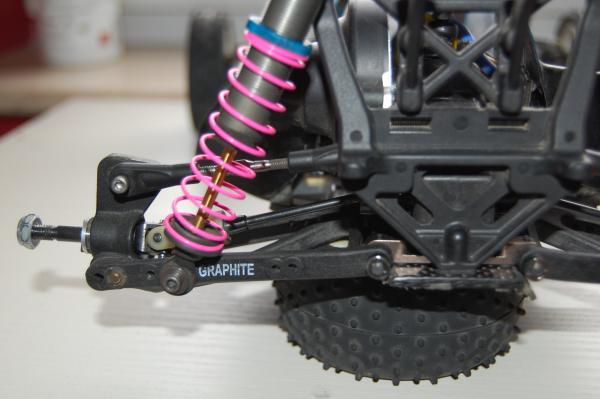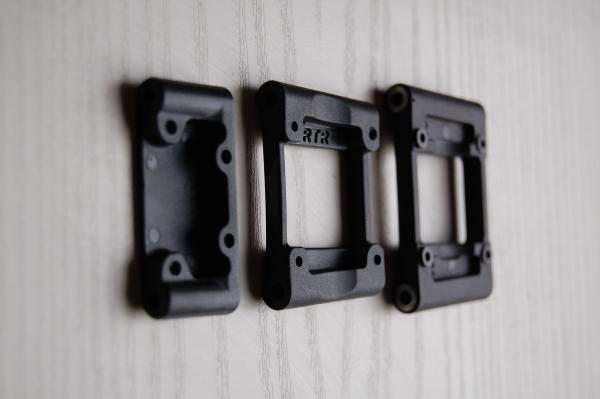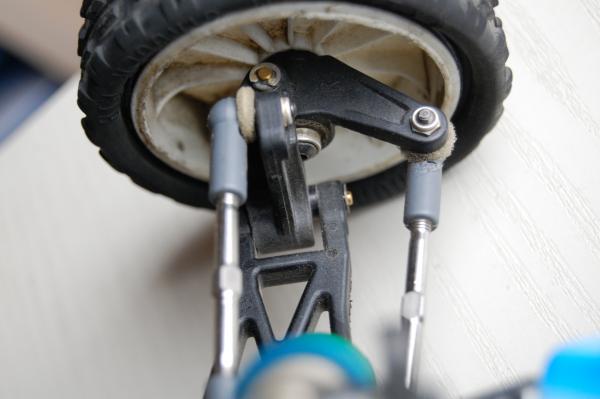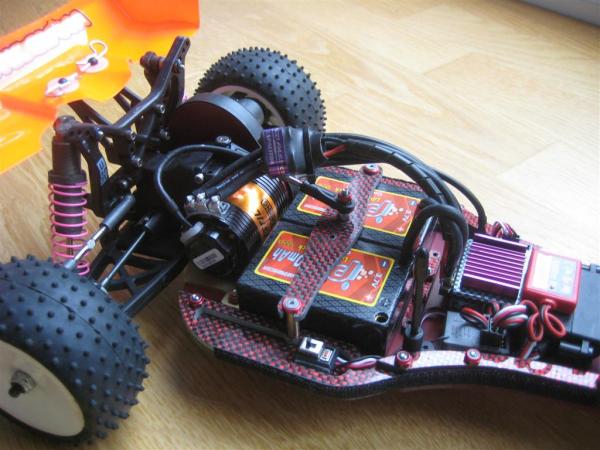The Atomic Carbon CR2 is an
excellent piece of kit but nothing is perfect. Here are some
modifications to the car, at this moment solely tested on astroturf
(high and medium grip) but each of them being a big improvement on the
handling of the CR2.
1) XXX rear end:
Those who are familiar with
the Losi Forum and/or have ever inspected the car of the Mighty Chris
Doughty might have seen this mod already. The rear XXX-CR suspension
(pivot block - wishbone - hub) is replaced by parts of the XXX and XXX-T
MF2. It looks like this:

and

The CR pivot block is very
wide, which is good for rough tracks. Its predecessor, the BK2, was
extremely narrow. And the XXX one is in between. So from narrow to wide:
BK2 < XXX < CR.
This creates an imbalance front and rear, which can be solved by fitting
the XXX block. The following image illustrates this:

The block on the right is
the standard CR one, as you can see it is a lot wider than the one in
the middle (XXX). On the left we have the front Losi pivot block (same
on XXX, CR and I think BK2 as well). Notice the same width of the XXX
front and XXX rear pivot block => balance.
On the first images you can
see which hubs I used: XXX-T MF2 ones. You can use the standard CR ones
but their bigger offset makes the car a few millimeters wider, which
isn't the goal of this mod. The standard XXX or BK2 hubs have the
perfect offset, but! have lower camber link mounting holes than the MF2
hubs have. I strongly suggest using the MF2 hubs (middle hole).
Part numbers:
- Pivot block: LOSA4126
(plastic) or LOSA4149 (aluminium)
- Wishbones: LOSA9800 (BK2 graphite) or XXX
- Hubs: LOSA2128
Both pivot blocks are good
but the plastic ones are prone to excessive play. If you don't want to
spend your earnings in an expensive alu one, simply use some spacers,
cheap and perfect as well.
Wishbones then. If you use the BK2 ones, use the short VLA hole. This
has the same length as the standard hingepin hole of a XXX wishbone.
Our findings? The Atomic
Carbon team in Belgium tested it during a club race and National @
Kampenhout, and found this rear end to be a big improvement. It gives
the car more steering while maintaining a lot of rear end grip. The
car's suspension reacts in a more balanced way as well. So far we
haven't noticed any downsides to this mod.
2) Front wheelbase mod:
This is a very simple one.
The idea is to extend the wheelbase of the car on its front end. So
dremel about 1,5mm off the front side of the hub (1,5mm is about the
thickness of a wheelbase spacer at the back) and move the hubs forward.
This will increase the total wheelbase, but that isn't the only goal.
When placing your front and rear hubs forward (so front long and rear
medium wheelbase) you don't make the car any longer, but maintain the
wheelbase. The only difference is that more weight is shifted to the
rear end of the car. Simply moving the rear hub forward does the same
thing, but the CR2 is already a short car, so with this mod you don't
make it any shorter and you'll still be able to get more weight to the
back. Here is an example:


The effect? I used both
front and rear long wheelbase, this made the car a lot more stable. It
gives you a little less steering, but most people will hardly notice it.
And while not being really faster over a single lap, it does make it a
lot easier to be fast on a consistent base. Again we are all using it
(with great effect, the CR2s had 1st, 5th and 7th place at the National)
as it makes the car a lot easier and more fun to drive.
3) Battery bar - 'the
Northy strap'
This is a picture of
Jonathan's car (I hope he doesn't mind):

As you can see it has only 1
battery bar, which makes it a lot easier to change batteries. You can
make it yourself out of a B4 battery brace but JC will make them himself
as well, and they look brilliant!
Secondly, the link going
from the top of the gearbox to the battery brace is an anti-flex link.
This way you don't need the brass gearbox brace anymore. Only difference
is that we made a small plate on top of the gearbox with a hole in the
middle, to have the link more in the center line of the car instead of
having to choose one of the (non-centered) holes.

